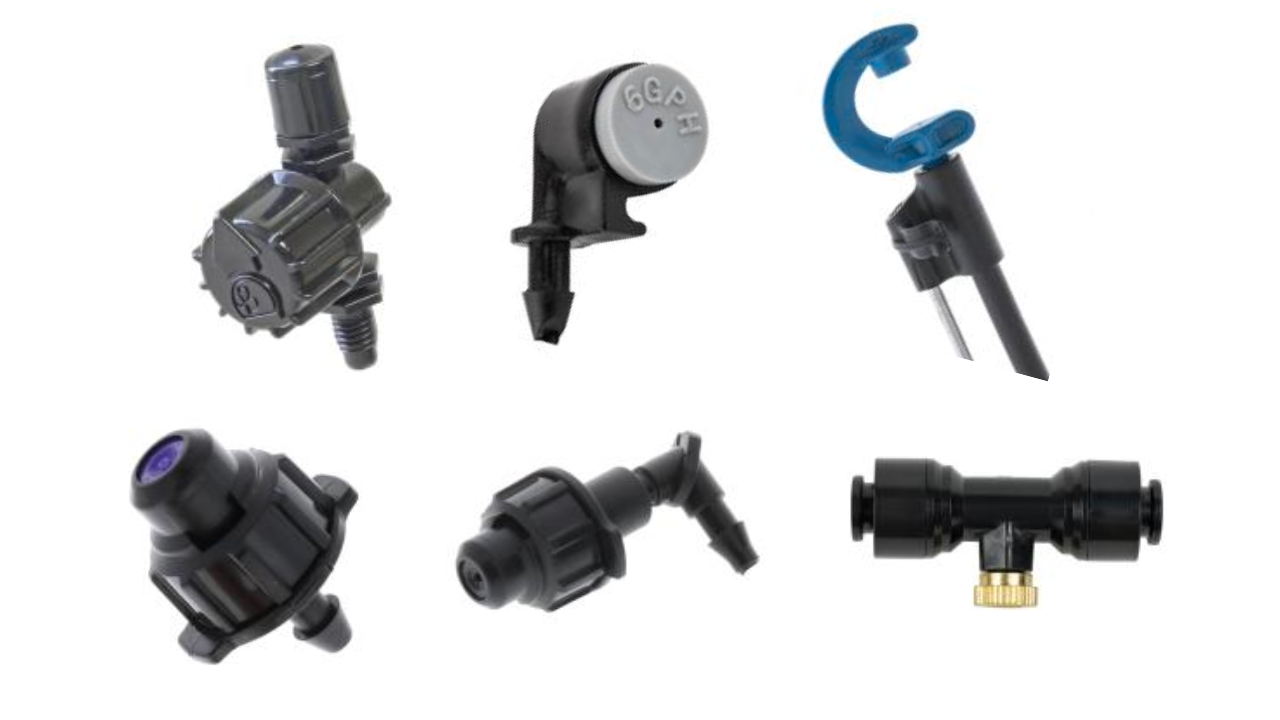Types of Drip Irrigation Emitters

We test and review gardening and other outdoor products based on an independent, multi-point methodology. If you use or links to purchase something, we may earn a commission. Read our disclosures.
Here are the most common types of drip irrigation emitters:
Button Drippers: Button drippers are the most common type of drip emitters. They are designed to throttle water pressure so that a uniform flow rate is released. That means with a button dripper, you get a predictable and smooth water flow to your plants. Drippers are used to water individual plants, and typical flow rates are 0.5 GPH to 2 GPH. There are pressure-compensated drippers and adjustable drippers.
Pressure compensation drippers: Pressure compensated drippers are button drippers that deliver precise amounts of water regardless of pressure changes in the tubing. Pressure changes can occur because of long tubing runs or hilly terrain.
Adjustable Drippers: Adjustable drippers have a small valve or dripper cap that the homeowner can turn top vary the amount of water emitted. Common GPH for adjustable drippers can range between 0 and 20.
Bubble Drippers: Bubbler drippers release water in an umbrella pattern. This allows for rapid watering at the root zone of the plant.

Vortex Drippers: Vortex drippers are similar to bubble drippers but emit water in a steady circular pattern. Vortex drippers have a larger coverage area than bubbler drippers.
Spray Jet Emitters: Spray Jet Emitters are another type of emitter where you can adjust the flow rate. They can spray water out in diameters far larger than standard drippers. The water arcs can be in 90, 180 or even 360 degrees. They are mainly used to water large areas.
There are three different types of spray jet emitters: strip jets, downsprayers, and pop-up spray jets. Spray jets will release water in two opposite directions. This allows the user to water a narrow area. Downsprays release water in downward, circular motion. Pop-up spray jets are spray jets that rise out of a larger tube like a pop-up sprinkler to release water.
Misters and Foggers: Misters and Foggers release water exactly how you think: misting and fogging. They are generally used to cool air around plants but they can also be used for water. The water is released in a very fine mist.
Inline Drippers: Inline drippers are flat disc drippers that are place in the line of tubing. These are typically used for micro irrigation. The drippers are flat discs that have hosebarbs on both sides that connect to smaller tubing.
Online Drippers: Online drippers are typically punched into the length of tubing along the drip irrigation lines and emit water directly at adjacent root zones. These have more flexibility than inline drippers are going to be used for plants with irregular spacing.
What Are Drip Irrigation Emitters?
Drip irrigation emitters are the end device that release water onto your plants. What do I mean by 'end device?' Typically, drip irrigation is run in long lengths of tubing.
The tubing runs from the water source to a garden or planting beds. The tubing can have emitters built into the line where water is released directly at the root zone of adjacent plants, or they can have emitters at the end of the line.
Drippers built into the tubing, as I mentioned above, are more common in drip tubing or drip tape irrigation systems. These emitters are spaced at equidistant spots apart along the length of the tubing.
However, small tubing can branch off from the mainline tubing to individual plants. At the end of this small tubing are emitters we talked about most in this article: button drippers, misters, foggers, bubble drippers, etc. And these are also the drippers most people know about (they just don't realize it), like sprinklers or spray jets.
What is the difference between drippers and emitters?
There is no difference between drippers and emitters. All drippers are emitters but not all emitters (technically speaking) just drip.
However, a dripper or an emitter is the end device that release water in a specific manner. You read above that some can drippers can release water to individual plants (button) while some emitters might be used to water larger areas (spray jet emitters).
Benefits of Drip Irrigation Emitters

The biggest benefits of drip irrigation emitters are the wide range of applications that they have. You can truly customize your drip irrigation system for any type of watering you need to perform.
But there are some other, general benefits that any good drip irrigation system will have:
- Water conservation
- Reduced weed growth
- Healthier plants
- Customizability
- Efficient watering
Ultimately, it comes down to how you are able to water your plants. Rather than just spraying at your garden with a hose and hoping for the best, you can control the flow rate, where the water is released, and how you want the water released - and that comes down to your emitters.
Final Say On Different Types of Drip Emitters
Now you know all about the different types of drip emitters. And there are a lot. Drip emitters are a critical component to any good drip irrigation system, and if you are a gardener who takes gardening serious, you are going to want to add some of these to your kit.
Types of Drip Irrigation Emitters FAQs
Before you go...
So that's it for my guide on drip emitters. They are critical for any drip irrigation system. But they aren't the only thing you need to know about when it comes to drip irrigation.
Be sure to check out some of our other guides so you can build the biggest and baddest garden around.

Carl Anderson
Carl Anderson is an avid outdoorsman with a keen interest in writing about and reviewing tools. He has over 20 years of writing experience and the only time he isn't feverishly typing away at his computer is when he's outside in nature working on his projects. You can learn more about him here.
Join our community!
Join to receive guides, insights, and the latest gardening deals!
